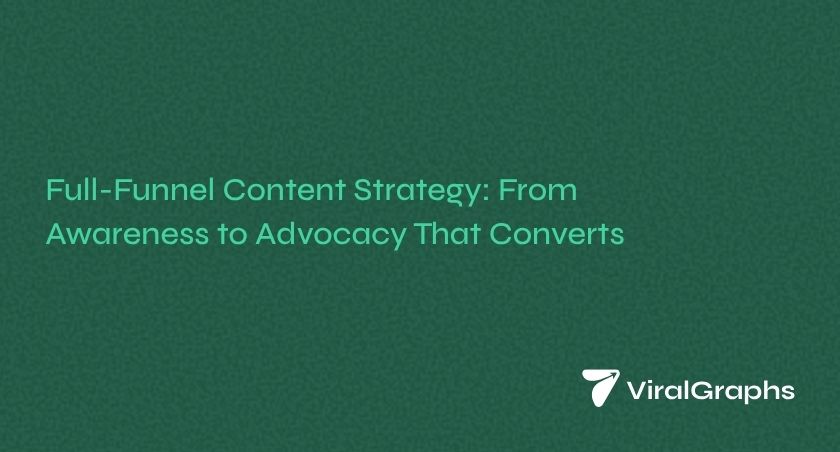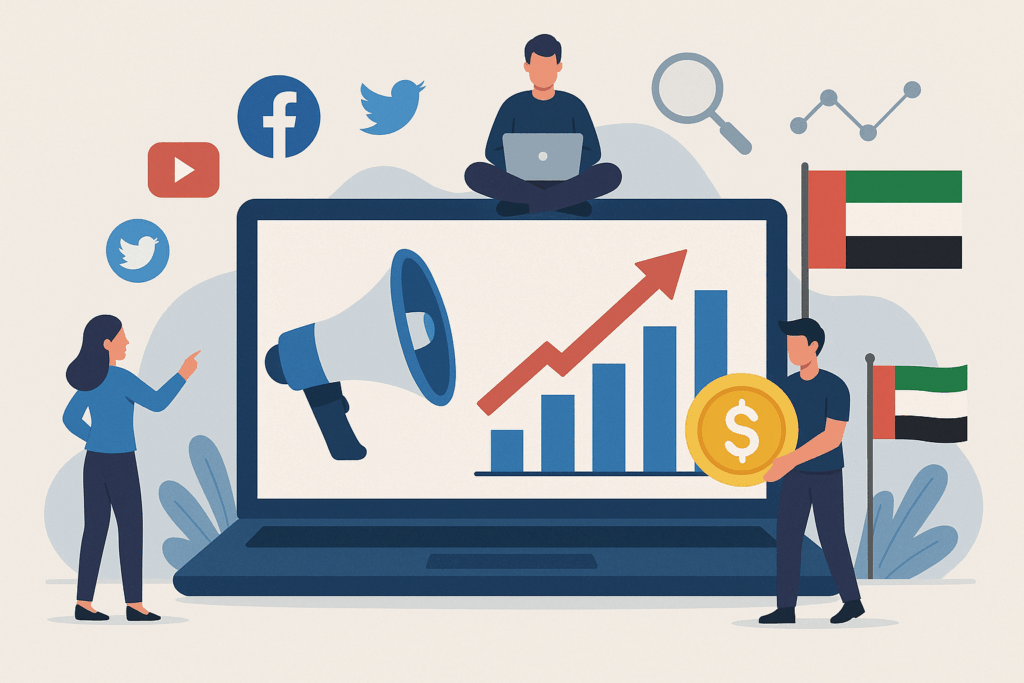76% of marketers say a full-funnel content strategy delivers better ROI. Still, so many businesses are stuck at the top.
2025 is an era where visibility is no longer enough. A blog, a social media post, or a landing page, everything matters today, but only when they fit into something bigger, i.e., a cohesive and full-funnel content marketing strategy.
Today, we’ll talk about how to align your content with every stage of the buyer journey (from the moment they discover your brand to the day they become your brand advocates). It’s not only about traffic or conversions but also about building a content engine that drives real growth.
What is a Full-Funnel Content Strategy?
A full-funnel content strategy is a comprehensive content plan that is explicitly designed to guide your audience through every stage of their buying journey, from awareness to conversion.
Instead of focusing solely on traffic or leads, this methodology aligns your messaging and content formats with specific content funnel stages, such as TOFU (top of funnel), MOFU (middle of funnel), BOFU (bottom of funnel), and loyalty/advocacy.
Each stage of this full-funnel marketing strategy serves a unique purpose in building brand trust and driving action.
Defining the Funnel
The marketing funnel strategy is designed in a ladder format where TOFU is at the top, MOFU is in the middle, and BOFU is at the bottom. After the BOFU ends, loyalty and advocacy emerge, encompassing the post-sale strategy. Let’s understand them individually:
- TOFU (top-of-funnel content): TOFU attracts new visitors by addressing their problems, not your product.
- MOFU (middle-of-funnel content): MOFU nurtures leads with valuable insights and comparisons that guide decision-making.
- BOFU (bottom-of-funnel content): BOFU provides convincing proof/demos, testimonials, and CTAs that drive action.
- Loyalty/Advocacy: Loyalty and advocacy are post-sale content strategies that retain users, build loyalty, and convert customers into brand advocates.
Why Content Needs to Cover the Entire Funnel in 2025?
- Nowadays, buyers don’t follow a straight line. According to a report by McKinsey, 57% of the purchase decision is made before a buyer contacts sales.
- This means your content must be present, persuasive, and personalized across every stage and every channel, fulfilling the comprehensive full-funnel content strategy.
- This strategy ensures that you are not just crafting content that gets seen, but that moves people forward and turns them into your loyal customers.
4 Stages of Full-Funnel Content Strategy
A winning full-funnel marketing strategy guides your audience step by step, from discovering your brand to becoming a loyal customer. The funnel is divided into four key stages, i.e., awareness, consideration, conversion, and loyalty.
Each stage requires different content types, goals, and tones. Let’s break them down, beginning with ‘top of funnel,’ where attention is earned and interest begins.
1. Awareness Stage TOFU (Top of Funnel): Capture Attention
The first stage of full-funnel content strategy is the awareness stage, where you educate and attract your audience. Your audience is not searching for your brand specifically. They are just searching for solutions.
And, this stage is about addressing their pain points and questions, not pushing or promoting your products. You can do this by following the best TOFU content formats as mentioned below:
- Blog posts
- Thought leadership articles
- Infographics
- SEO-optimized content
- Social media carousels
- Short-form videos
In this stage, you rank for the question, not the product. Awareness begins with what your audience is Googling, not what you are selling.
2. Consideration Stage MOFU (Middle of Funnel): Build Trust
Next comes the consideration stage, where your goal is to nurture and differentiate your audience. Once someone identifies their problem, they begin searching for solutions.
This is your moment to showcase your expertise and provide clarity, helping your audience evaluate their opinions. It’s about building trust, not pitching hard, but proving that you are the right fit. You can do this by following the best MOFU content formats listed below:
- Case studies that highlight outcomes.
- Webinars with live Q&A or expert panels.
- Email nurture sequences with segmented messaging.
- Comparison guides and solution explainers.
- Interactive tools like quizzes or ROI calculators.
For example, Outbrain’s ‘Amplify Success Stories’ case study hub is a MOFU powerhouse, turning mid-funnel curiosity into confident consideration.
3. Conversion Stage BOFU (Bottom of Funnel): Drive Action
The third stage of a full-funnel content strategy includes the conversion stage, where you confidently convert your audience into customers. In this stage, your audience is nearly ready to buy, but hesitation still exists.
At this stage, your content must address objections, showcase proof, and make taking action easy and risk-free. Always remember, the key is ‘clarity,’ ‘credibility,’ and ‘urgency.’ You can do this by following the best BOFU content formats given below:
- Product demo videos or live walkthroughs.
- Customer testimonials and reviews.
- Limited-time offers and incentives.
- Free trials, audits, or strategy calls.
- One-pager solution sheets tailored to use cases.
Your CTA here shouldn’t invite, but solve. Speak directly to the pain point and show your audience what they gain by taking action now.
4. Post-Purchase Stage: Loyalty & Advocacy
The last stage is the ‘post-purchase stage,’ where you turn your audience into customers and want them to become your brand advocates. You must keep in mind that retention fuels revenue and advocacy amplifies reach.
Now, as the conversion is done, you need to focus on ‘delivering value beyond the transaction,’ nurturing trust, encouraging repeat purchases, and giving a reason to spread the word. In order to encourage loyalty, you can focus on the following content types:
- Onboarding email sequences.
- Help center guides and how-to videos.
- Loyalty programs and exclusive perks.
- Upsell or cross-sell content through smart segmentation.
To encourage your users to become brand advocates, ensure that you focus on creating robust brand awareness content types as given below:
- User-generated content (UGC) campaigns.
- Customer spotlight stories.
- Incentivized referral programs.
- Community-building via forums or social groups.
Always remember that loyal customers don’t just return, they refer, review, and rave.
How to Measure Full-Funnel Content Strategy Performance?
Crafting content is only half the job. You need to measure its impact to drive smarter decisions and better ROI. A full-funnel content strategy requires stage-specific KPIs and the right attribution model to identify what’s truly driving results.
Funnel Metrics that Matter
Every stage of full-funnel content strategy has its own success signals, such as:
- Awareness: Impressions, time on page, new users.
- Consideration: Click-through rate (CTR), engagement rate, email signups.
- Conversion: Conversion rate, Customer Acquisition Cost (CAC), Return on Ad Spend (ROAS).
- Advocacy: Net Promoter Score (NPS), repeat purchase rate, customer referrals.
These metrics help you spot content gaps, optimize touchpoints, and scale what works.
Attribution Models to Use
Don’t let the wrong model skew your insights. Make sure to use attribution that reflects how your audience interacts:
- Multi-Touch Attribution: Credits every touchpoint in the content for customer journey, which is ideal for long cycles.
- Time Decay: Weighs recent interactions more heavily,
- First Click vs. Last Click: Good for quick wins, but risky for complex journeys.
However, you can combine attribution models with funnel metrics to build a 360° view of content performance.
Summing Up
A full-funnel content strategy doesn’t just attract but also nurtures, converts, and retains. It is not about putting content everywhere, but about crafting a journey that moves people forward with purpose.
Are you ready to stop the guesswork and start guiding your audience more effectively? Contact ViralGraphs today to build your full-funnel marketing strategy.









